Kevin Low Painter - Glasgow, Scotland
Your current exhibition is ‘Women and Men’ at Union Gallery in Edinburgh, discuss the title and how the exhibition was named.
The title chose itself really. I’ve spent the past two years exploring and experimenting / messing about with paint. My main discovery or what I realised I had to do, was to strip things away. There had been too many ideas crowding that one little rectangle. I’m a figurative artist, so when it came down to it, there was very little left other than the ‘Women & Men’.
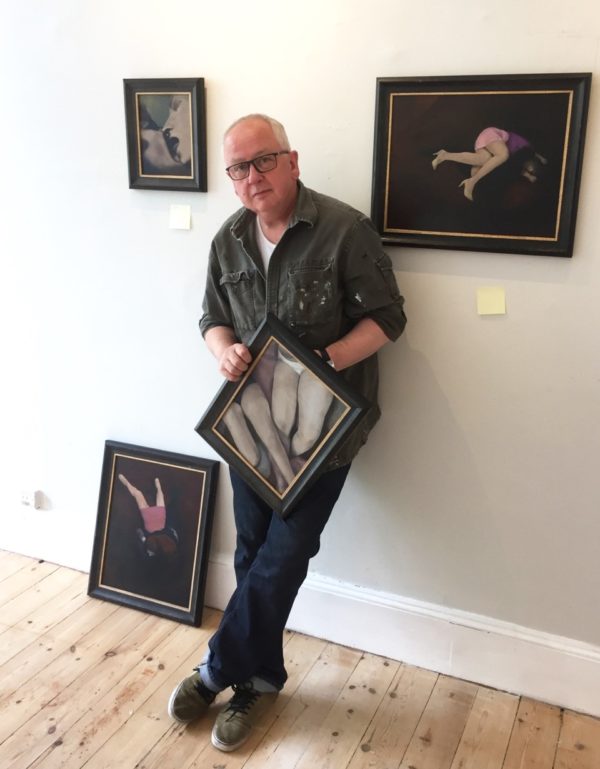
How many pieces have you had to complete for this Solo exhibition?
There are 21 paintings in the show… there were more, but these are the survivors. I promised myself when I began working on this show that I would be brutally honest with myself. If I am doubtful about a picture, I allow it to lie around the studio for a few weeks, then, if I can’t see a way forward with it, it’s off to the bonfire. Destroying unsuccessful work can be a fantastically creative thing; it stops your thoughts getting slowed down with all that gloop of the near miss and the wrong turn.
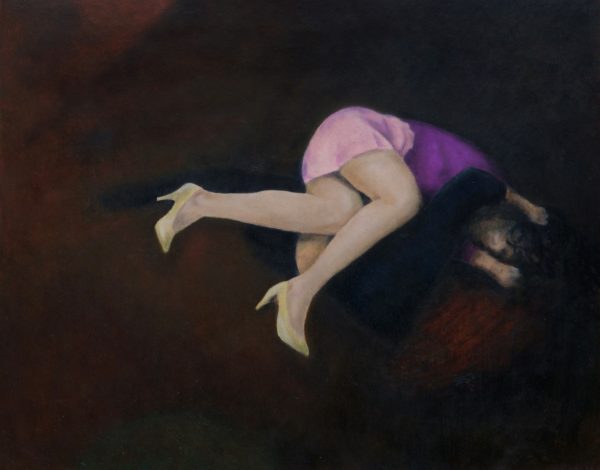
Sisters IV, Oil on board, 37 x 47 cm
Discuss the ‘domestic familiarity’ of one of your works.
This something I hadn’t realised. I was looking for an atmosphere rather than having a clear idea of the images I would make. I knew I didn’t want formal. I wanted to avoid show biz, the images to somehow be real, to catch mundane moments and find the tiny magic there is in them. My bodies are not those of gymnasts or fashion pages. I wanted, I suppose to look at a world that was believable not aspirational. There is always a bit of biography in my work, and this is how I remember things, without much daylight.
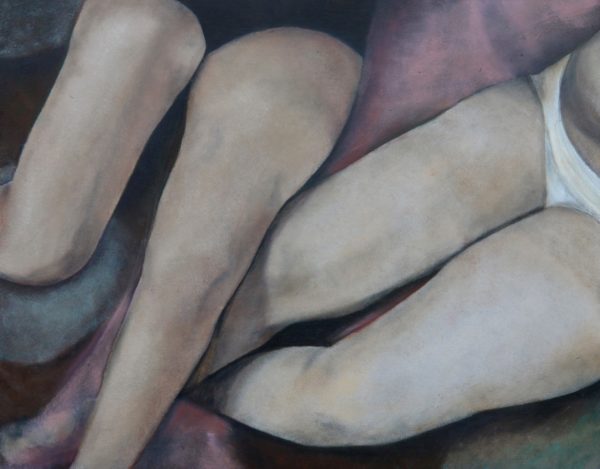
Pale Legs, Oil on board, 27 x 34 cm
The domestic aspect of your works, are reminiscent of Degas domestic paintings discuss.
…Yes, I can sort of see that sometimes. Photography was important to him as well, the realisation that a scene can be capturing without the necessity of completeness, that the viewer can imagine beyond the cameras frame, beyond the artists eye. His work took a step backstage, avoiding the front of house glamour to gaze at the mundane moments of dancers dressing and bathing.

Woman Undressing, Oil on board, 37 x 47 cm
You also worked as a photographer. How does your photography influence the frame within your paintings?
The photographer Cartier Bresson was all about the ‘decisive moment’, the height of the action. Working as a theatre photographer, documenting an opera performance that ability was essential. In away what I’m searching for in my current work is the exact opposite. It’s the moments in between that I’m interested in, that ill defined awkwardness after the instigation of the action and before its resolution… let’s call it the mundane middle, there’s something special in there.
In your earlier career you worked as a Theatre Photographer explain what this involved?
I had a fantastic time. I was working and collaborating with a great variety of directors and writers. I was commissioned to produce images to promote their work and to document the performances. Very inspiring, but things became more and more frustrating. I was photographing other people’s work when I felt I should be creating my own. One day as I sat looking at my diary, pages mapping out the days documenting others work and I thought, no, can’t do it, and I jumped… it felt wonderful!
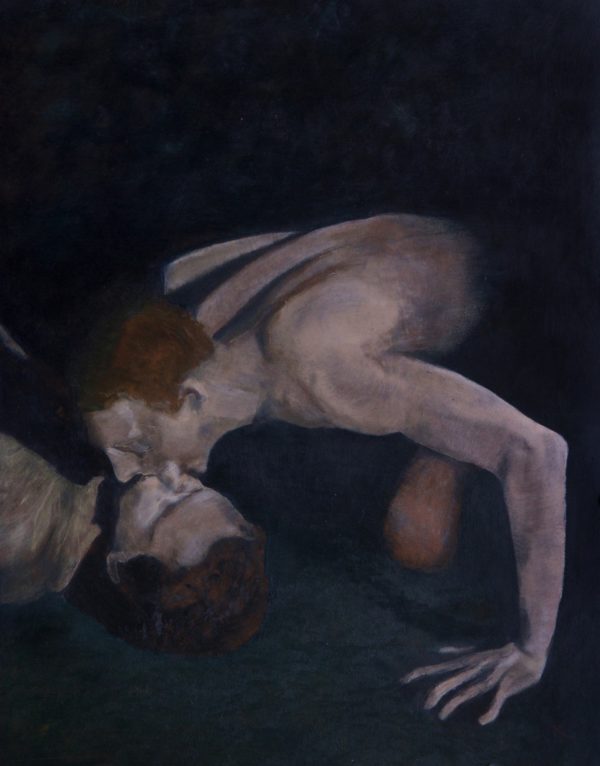
Untitled, Oil on board, 27 x 34 cm
Discuss the backdrop in your current work.
This is the first time I have shown work in a couple of years, things have changed. As I mentioned earlier I’ve spent a lot of time experimenting, playing with ideas. After a lot of false starts and sulking, but nothing that couldn’t be shaken off by bouts of swearing, loud music and coffee, I came across the thing, an atmosphere that I recognised as mine.
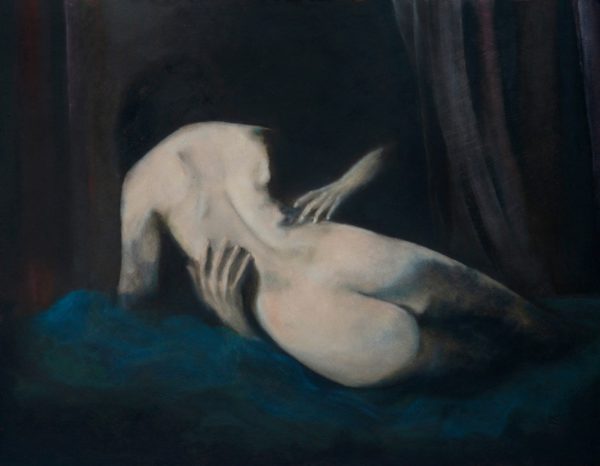
Woman and Man on a Blue Bed, Oil on board, 37 x 47 cm
The new work is oil on board, all my previous work has been digital. Life in the studio is now much messier, that’s part of it really; there’s a thrill in the wet and messy. I was finding that the moving around of pixels wasn’t giving me that spark in my gut. This is a bit of a cliché I know, but I became more and more aware of the ‘mark making’ in other artists work, their signature push and pull of the brush. I found that working digitally I couldn’t do that. The joy of an oil painting is those ‘mistakes’ the fumbles and alterations to the artists thinking, all that leaves little scars that I love. If I’d done that with a digital painting, it would have been faux. A mistake can be undone at the click of a mouse. Digital painting has the possibility of giving you seamless perfection, that’s its strength. When it comes right down to it, what I’m saying is that I wanted more of me visible.
Some people have looked at the work for this new show and have said, ‘That’s not just a shift in process, it’s a huge leap to somewhere else.’ And it is, sort of… but new work, for any of artist, is never a leap, no matter how seemingly radical the move. It is… it has to be, a culmination of everything that has come before, not just the art or the making. You’ve got all the nightclub nights, the broken hearts, the years of really terrible TV. It’s all there… and it’s now here, mangled and funnelled into ‘Women & Men’.
Contact details:
Kevin Low
Kevin Low, Glasgow, Scotland
Interview by Deborah Blakeley, August 2017
Think a colleague or friend could benefit from this interview?
Knowledge is one of the biggest assets in any business. So why not forward this on to your friends and colleagues so they too can start taking advantage of the insightful information the artist has given?
Other artists you may be interested in:





